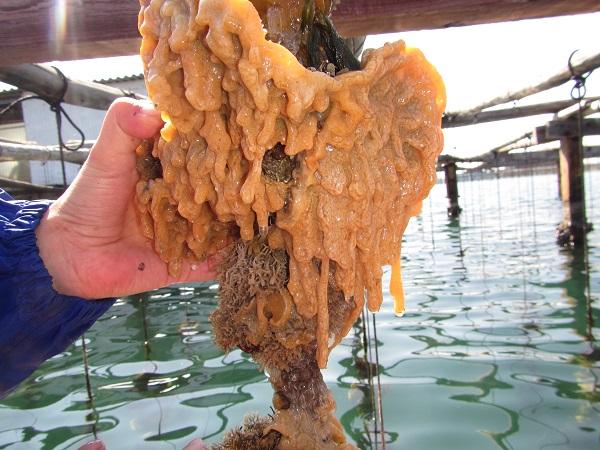Didemnum vexillum: A global invader

Credit: Xavier Turon (CEAB-CSIC)
A new article published in the journal Scientific Reports reveals 44% of the colonies of Didemnum vexillum -a marine invertebrate tagged as invasive species- in the Ebro Delta (Tarragona, Spain) are formed by gene chimera, that is, cells with different gene pool. According to the study, this ability to create chimera could be a determining factor to promote genetic diversity and the colonizing success of this exotic species in natural ecosystems worldwide.
The experts Marta Pascual, from the Faculty of Biology and the Biodiversity Research Institute of the University of Barcelona (IRBio), Xavier Turon, from CSIC in the Blanes Centre for Advanced Studies (CEAB), Maria Casso (UB-IRBio-CEAB-CSIC) and Davide Tagliapietra, from the Institute of Marine Sciences (Italy) -took part in the new article.
Didemnum vexillum: a global invader
Ascidians are a marine group of invertebrates from the sub-phylum of tunicates with a great ability to colonize marine habitats (ocean floors, harbours, navies, aquaculture facilities, etc.) and unchain episodes of biological invasions with a high economic and ecological cost. In marine ecosystems -especially vulnerable to the problem of biological invasions- human activity related to intense marine traffic have eased the spread of invasive organisms in several areas of the planet.
The colonial ascidian Didemnum vexillum is an exotic species from the northern-western Pacific which successfully spreads in mild waters worldwide. A great competitor for natural resources, this dominant-profile species has high reproductive skills, it forces native species to move and spreads easily through ships and aquaculture activities.
Identified for the first time in the Mediterranean in 2012, in the Venetian Lagoon (Italy), this exotic species was also registered in aquaculture facilities in the Ebro Delta in Tarragona. Today, it is widely distributed around the Mediterranean basin, and this is why it is essential to know about its biology and ecology to limit its colonizing power and prevent new expansion episodes from occurring in marine ecosystems.
Chimera: from ancient mythology to the natural world
In Greek mythology, chimera were fantastic creatures with features from different animals. In nature, the creation of chimera bodies -constituted by cell lines with different genetic origins- is a process that can happen spontaneously in some organisms. Regarding colonial species such as ascidians, the natural chimera is defined by the presence of parts of the colony with different genotypes.
The frequency of chimera in nature varies in different species, “and in modular organisms, such as colonial ascidians, sponges or corals, the process of creation of the chimera is possible”, notes researcher Marta Pascual, from the Laboratory of Evolutionary Genetics of the Faculty of Biology (UB-IRBio). “In the frame of evolution -she continues- the formation of chimera makes genetic diversity to be larger. Also there is a hypothesis that states that it could be a mechanism to increase the adaptive success in a new environment”.
Chimera in invasive ascidian in the Ebro Delta
In the new study, whose first author is the doctoral student Maria Casso (UB-IRBio-CEAB-CSIC), researchers applied whole genome amplification protocols (WGA) and genotyping-by-sequencing techniques (GBS). In a previous study (
Biological Invasions
, 2019), the research team showed the reliability of WGA and GBS protocols to conduct genomic analysis with minimum amounts of biological material.
The new study quantifies the prevalence of chimera in populations of invasive ascidians in the Ebro Delta and reveals 44% of the studied colonies are chimera. However, there are doubts on the mechanism that determines the formation of chimera in the ascidian Didemnum vexillum. “When two colonies are near each other they can merge or reject the other. However, the mechanisms that can favour this merge are not clear yet”, notes researcher Xavier Turon (CEAB-CSIC).
The experiment in Venice
Simultaneously, another objective of the article was to determine whether the ascidian colonies that merged were genetically more similar than those showing rejection. With this goal, they analysed the merging process in ascidian colonies in the Venetian Lagoon, through an experimental protocol that put in contact samples from a same colony and fragments from different ones.
The colonies that merged in the experiments carried out in the Institute of Marine Sciences in Venice (Italy) did not share more genomic similarities than those that did not merge. Therefore, there are not genetic differences globally between both analysed groups, except for some loci or genomic regions -with an unknown biological function due the lack of reference genomes- where there was a major similarity regarding genetics.
The analysed populations of ascidians in the study are part of the European genetic group where the Atlantic colonies of the Brest population are integrated too. The recently published results (Biological Invasions, 2019) by this research team show there have been three episodes of independent colonization episodes in the colonization of this species at a global scale. Conclusions reveal there are significant gene differences among populations in each group. In the European group, the Ebro Delta population shares more gene similarities with the Brest population instead of the Venice one, results which may appear this way due the colonizing process and the genetic drift. However, researchers warn they still have to know more about the role of natural selection in this process.
###
Media Contact
Rosa Martínez
[email protected]
0034-934-035-544
Related Journal Article
http://dx.




